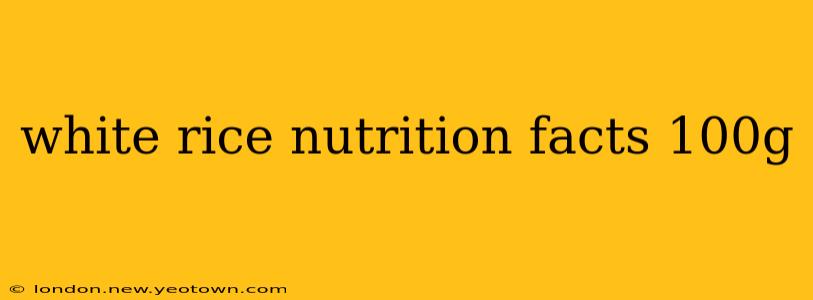White rice, a staple food for billions worldwide, is a versatile grain that finds its way into countless dishes. But beyond its culinary appeal lies a nutritional profile that deserves closer examination. Let's explore the nutritional facts of a 100g serving of white rice, addressing common questions and delving deeper into its impact on health.
We'll be looking at a typical serving of cooked white rice, as the nutritional content can vary slightly depending on the type of rice and cooking method.
White Rice Nutrition Facts (per 100g cooked):
This is an approximate value and may slightly vary depending on the specific type of white rice and cooking method. Always check the nutrition label on your specific product for the most accurate information.
- Calories: Approximately 130-140
- Carbohydrates: Approximately 28-30g (primarily starch)
- Protein: Approximately 2.5-3g
- Fat: Approximately 0.3-0.5g
- Fiber: Approximately 0.4-1g (significantly lower than brown rice)
- Sugars: Approximately 0.5g
Minerals & Vitamins (amounts vary depending on the rice and soil it was grown in): White rice is generally a good source of manganese, and provides smaller amounts of other vitamins and minerals such as thiamin, niacin, and iron. However, the milling process removes the bran and germ, reducing the nutrient density compared to brown rice.
What are the main nutrients in white rice?
The primary nutrient in white rice is carbohydrates, largely in the form of starch. This provides the body with energy. While it contains small amounts of protein, it's not considered a significant source. The fat content is minimal. The vitamin and mineral content is lower compared to whole grain options like brown rice due to the milling process.
Is white rice good for weight loss?
White rice's high carbohydrate content and relatively low fiber can contribute to blood sugar spikes. While it can provide energy, its impact on weight loss is complex. Moderation is key. Incorporating white rice as part of a balanced diet and regular exercise routine might be suitable for some, while others might find it less beneficial for weight management. The glycemic index (GI) of white rice is relatively high, meaning it can cause a rapid rise in blood sugar levels.
How many calories are in a cup of cooked white rice?
A cup (approximately 195g) of cooked white rice contains roughly 200-220 calories. This amount varies depending on the type of rice and cooking method.
What are the benefits and drawbacks of eating white rice?
Benefits:
- Readily available and affordable: White rice is widely accessible and relatively inexpensive, making it a staple food for many.
- Source of energy: Provides carbohydrates for energy.
- Versatile: Can be incorporated into a wide range of dishes.
Drawbacks:
- Low in fiber: The refining process removes much of the fiber, which is important for digestive health.
- Low in nutrients: Compared to brown rice, it has lower levels of essential vitamins and minerals.
- High glycemic index: Can lead to blood sugar spikes.
Is white rice healthier than brown rice?
No, brown rice is generally considered healthier than white rice. Brown rice retains its bran and germ, making it a better source of fiber, vitamins, minerals, and antioxidants. It also has a lower glycemic index.
Conclusion:
White rice can be a part of a healthy diet when consumed in moderation as part of a balanced meal plan. However, its lower nutrient density and higher glycemic index compared to brown rice should be considered. For optimal health, incorporating a variety of whole grains and other nutrient-rich foods is crucial.

